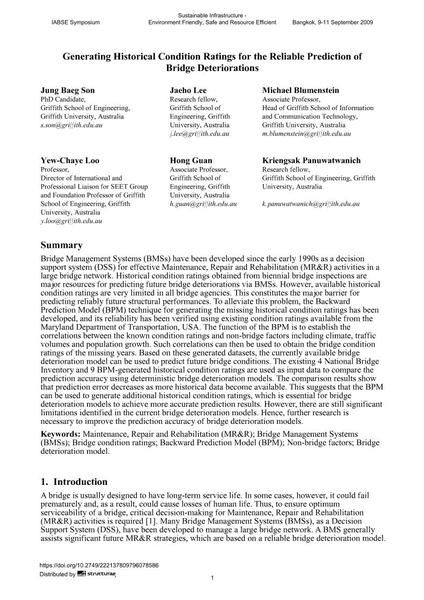Generating Historical Condition Ratings for the Reliable Prediction of Bridge Deteriorations

|
|
|||||||||||
Bibliografische Angaben
| Autor(en): |
Jung Baeg Son
Jaeho Lee Michael Blumenstein Yew-Chaye Loo Hong Guan Kriengsak Panuwatwanich |
||||
|---|---|---|---|---|---|
| Medium: | Tagungsbeitrag | ||||
| Sprache(n): | Englisch | ||||
| Tagung: | IABSE Symposium: Sustainable Infrastructure - Environment Friendly, Safe and Resource Efficient, Bangkok, Thailand, 9-11 September 2009 | ||||
| Veröffentlicht in: | IABSE Symposium Bangkok 2009 | ||||
|
|||||
| Seite(n): | 44-53 | ||||
| Anzahl der Seiten (im PDF): | 8 | ||||
| Jahr: | 2009 | ||||
| DOI: | 10.2749/222137809796078586 | ||||
| Abstrakt: |
Bridge Management Systems (BMSs) have been developed since the early 1990s as a decision support system (DSS) for effective Maintenance, Repair and Rehabilitation (MR&R) activities in a large bridge network. Historical condition ratings obtained from biennial bridge inspections are major resources for predicting future bridge deteriorations via BMSs. However, available historical condition ratings are very limited in all bridge agencies. This constitutes the major barrier for predicting reliably future structural performances. To alleviate this problem, the Backward Prediction Model (BPM) technique for generating the missing historical condition ratings has been developed, and its reliability has been verified using existing condition ratings available from the Maryland Department of Transportation, USA. The function of the BPM is to establish the correlations between the known condition ratings and non-bridge factors including climate, traffic volumes and population growth. Such correlations can then be used to obtain the bridge condition ratings of the missing years. Based on these generated datasets, the currently available bridge deterioration model can be used to predict future bridge conditions. The existing 4 National Bridge Inventory and 9 BPM-generated historical condition ratings are used as input data to compare the prediction accuracy using deterministic bridge deterioration models. The comparison results show that prediction error decreases as more historical data become available. This suggests that the BPM can be used to generate additional historical condition ratings, which is essential for bridge deterioration models to achieve more accurate prediction results. However, there are still significant limitations identified in the current bridge deterioration models. Hence, further research is necessary to improve the prediction accuracy of bridge deterioration models. |
||||
| Stichwörter: |
Wartung
|
||||
